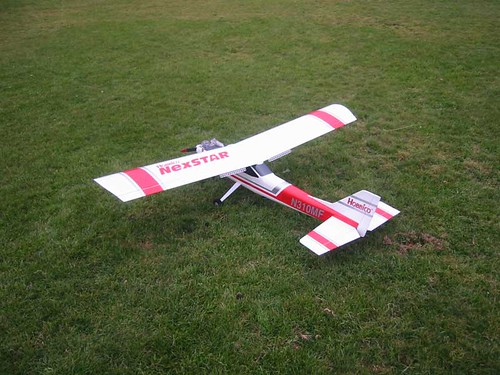Tuesday, October 21, 2008
I've been bitten.....
Last Friday I bought Hanger 9's FS-One Precision RC Flight Simulator. It comes with a controller of the type used to fly these models and a big selection of types of aircraft (it even includes helicopters!), areas to fly in, etc. I've played a bit with it, enough to learn that I have a lot to learn before I can take off and then get the plane back on the ground in one piece. That is the preferred way but it makes a lot more sense to do my crashes on the simulator, where I just push a button to return the aircraft to pristine condition. And they fly very realistically. I can dial in wind, both constant and variable, as well as fly it from pavement or grass and probably other surfaces. I know there is even at least one inside venue that can be used, but that is for small electric aircraft.
I also did some looking around, reading of magazines and talking with people. It turns out that Pat's son in law is a R/C flyer who has half a dozen different planes and is a past president of the Skagit Valley R/C Club, a chapter of the national AMA club. I think I will probably join them both and J has said he will teach me to fly. The plane I settled on is a Hobbico NexSTAR 46 Select RTF. The RFT means "ready to fly" and it comes out of the box pretty close to being ready. I ordered it today from the local hobby shop. I have a few photos that are from the distributor of the plane:

This is a pretty large model with a wing span of almost 6 feet (68 3/4") and a fuselage length of 56 inches. It weighs about 6 1/2 pounds, before it's fuel tank is filled with 9 fluid ounces of glow engine fuel.

This view shows the SpeedBrakes Training Flaps allow it to fly at a very slow speed. I've read that it will land at about 17mph. All this is good in a trainer that helps the novice pilot handle the controls before having a serious accident occur to the plane.

It also has what is called automatic flight stabilization which will level the plane out from almost any position the pilot gets it into. This sounds like it may be a good thing for a novice to help preserve the plane and it can be dialed down in it's strength as the pilot learns how to fly the plane, eventually turning it off. More on this later after I try it. Anyway, this photo shows the sensor on the bottom of the body just behind the wheels that makes this system work.

This front view shows another feature that is on the front of the wings, called SpinControl Airfoil Extensions. These are wing droops that provide lift even in a stall to keep the plane level and allow the pilot to regain control. They are also removable after the pilot gets to where they are not needed.
The radio control that comes along with it is a Futaba unit which I guess is one of the best brands. The receiver and all servos are built into the plane and already connected, except to the elevator that are connected in that final 20 minutes needed before flying. The kit comes with another simulator that actually uses this radio to fly the sim and it is with this specific plane with it's aerobatics already programmed in. I'll install it and fly that until I get to where I can make landings successfully before we go out to fly the real thing. Then, I'll hook my radio to J's and have him take it off, then let me fly it but with his radio in command so he can take control back immediately if I have a problem.
You would never guess that I am enthused about this. I've wanted to do something like this all of my life and now finally have the time and money to do so. My plane should be here by the weekend or first of next week at the latest. When I get it together I'll figure out how to get some photos of my actual plane, with me included in one or two so you can see the size. I'll want those as a reminder of how I want to keep it. No crashes!!!!!
Labels: Flying, Photos, Radio Controlled Airplanes
I'll be watching for the pics of the new plane. Are you gonna name it?
xoxoxo
Diane
My goal with the blog is to help promote our fun and exciting hobby. I am glad to see that you have enlisted the help of an experienced flier. That is what I recommend for anyone getting started.
Have a look at my website and pass the word along. Be sure to check the About page.
From OldManFlier
Dwight Hunter
<< Home


